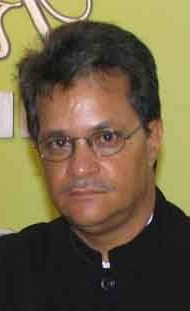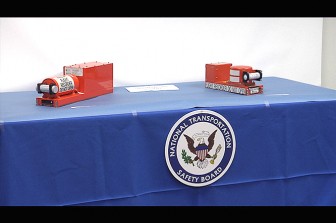All systems at the Cheddi Jagan International Airport (CJIA), Timehri were up and running when the Caribbean Airlines (CAL) jet crashed there early Saturday says veteran pilot Gerry Goveia who suggested that pilot error or the plane itself is likely the cause of the accident.
While stressing the need to wait on the investigators’ report for definitive answers, Goveia- who owns his own airline – said that there are three things that can cause an aircraft accident: the man, the machine and the environment. “Nothing was wrong with the environment, nothing was wrong with the airport, nothing was wrong with the weather,” he told Stabroek News in an interview yesterday. “This accident is either the plane or the pilot. Not the airport, not the environment…it was the man or the machine,” he said.

US National Transportation Safety Board (NTSB) investigators along with their local and regional counterparts yesterday continued examining the Boeing 737-800 jet which broke in two after it overshot the runway and plowed through the perimeter fence of the airport at about 1:32am on Saturday. The flight recorders of Caribbean Airlines Flight 523 are at NTSB headquarters in Washington where the data will be downloaded. There were 163 passengers and crew onboard the Boeing 737-800 aircraft at the time of the crash. Miraculously, there were no fatalities.
Yesterday also, the tail of the aircraft was dislodged from the body of the aircraft and the authorities are looking to hoist the entire aircraft within the next couple of days to the airside of the CJIA. Reports are that they plan to rest the jet on one of the main taxiways at CJIA as investigations continue.
No fog
Meanwhile, Goveia said that standards at the CJIA are not the issue in relation to the crash-landing. It was noted that this was being raised by the Trinidadian media. “There’s no issue with the runway lighting. Our runway lighting are fully to the level of ICAO standards. The Air Traffic Control System is right there as well,” he said. In addition, he said, the instrument approach system has nothing to do with this accident. “That night there was no fog, there was light rain at the airport and whether there was fog or there was light rain or whatever it was, the decision to land is the pilot’s sole responsibility”, he said.
In relation to the runway being “too short,” Goveia said: “there’s nothing like a (runway) being too short.” He explained that planes operate into airstrips of a determined class and a category. “The physical dimension matches the manufacturing safety for these airplanes,” he said. “Aviation is an exact mathematical science.” Further, Gouveia stressed that the CJIA is approved by all international agencies for all weather, night and day operation. “Timehri airport is a fully approved airport that meets all international standards. If not, Caribbean Airlines themselves would be delinquent to operate into an airport that is not approved,” he observed.
Gouveia noted that the type of aircraft that operates at CJIA needs 6000 feet but the runway is 7500 feet. “These planes are approved to land on runways of this level because of the speed at which they land at so, so long as they land on the correct spot on the runway, the reverse thrust and the brakes are meant to stop this airplane way, way, way before the end of the runway,” he explained. As long as the plane touches down at the threshold and at the right speed, the brakes and the reverse thrust will stop the aircraft, he said. With regards to slickness of the runway, he said that if there is a heavy downpour, there will be water but the runways are built so that water runs off quickly.

In ruling out the airport and the environment as probable causes of the accident, Goveia said that the investigators have to determine if something went wrong with the plane like if the brakes failed or if the pilot operated the aircraft in a manner not in conformity with what is required.
80% of aircraft accidents are caused by human error and probably 90% of accidents like this one are due to pilot error, he said while cautioning against second-guessing the investigators.
Goveia also pointed out that according to eyewitnesses accounts, the aircraft did not touchdown where it normally would. “Now if you have a runway that is 7500 feet, it is incumbent that you land on the threshold of the runway. You cannot land halfway down the runway,” he said. “Whether it is a plane malfunction or the pilot had a problem, the investigators would have to tell us this,” the veteran pilot added.
“This accident is either the plane or the pilot. Not the airport, not the environment…it was the man or the machine,” he said. One of the greatest challenges facing investigators and safety managers in aviation is how to manage the human factor, he noted. This will form a major part of the investigation in this case. Goveia stressed that despite this incident, CAL remains one of the safest airlines in the world and still maintains their record of no fatalities.
Response
Meanwhile, with regards to the response to the accident, Goveia pointed out that the CJIA goes through emergency drills on a regular basis. He said that every time, an aircraft is about to land, the control tower notifies the fire service so the firemen can prepare. “When they (firefighters) saw this airplane coming in and when they saw where that aircraft touched down and start hearing the screeching of the brakes, those men immediately start up that fire engine and went. So as that airplane went over the hill, the fire tender was right behind them,” Goveia said. “Anybody that says that our firemen was not in position are lying through their teeth,” he declared. He said that upon arrival, they beamed their lights on the aircraft and were prepared in case a fire broke out.
When it was pointed out that passengers said that there were no rescuers as they came out of the plane, he said that nobody is going to be on the ground immediately after an accident and this is unrealistic. It happened in seconds, he said. According to Goveia, when the fire tender arrived at the top of the slope, the firemen stayed with the tender to man the equipment in case a fire started and some went down to help but it could not happen instantaneously. The firemen “are heroes and were on the ball. I cannot be critical,” Goveia said. He said that shortly after, the GDF ambulance turned up, as well as the police and army to secure the site.
However, he said, he remains concerned at the medical system in place. “Our medical response systems is where I believe we were a little slow,” he said adding that this could be because of the distance of the airport. Medical help has to come from the city which would take some time and that is a challenge, he said. He noted that there is a small medical contingent at the airport which kicked into gear with the GDF medical personnel “but when you think abut 200 people, 150 people who might have needed medical attention, this is where I believe that we need to look at in the future.”
“Maybe it would make sense to build a small hospital close to that airport that could service the people in the Timehri area and be on standby at the airport. Maybe that’s what we need to do,” Goveia said. He noted that in the aftermath of the incident, there was the biggest deployment of medical personnel and equipment at the airport but the issue remains one that needs to be seriously examined.
Meanwhile, Goveia said that if the aircraft was going 10 knots slower or faster, the results would have been disastrous. He noted, according to passengers’ accounts, that the inside of the airplane was plunged into darkness when the plane was still on the runway as the pilot likely realized that they were going to overshoot the runway. “Their (pilots) actions contributed to the plane not burning because they shut down the electric, they shut down the engine and so on…which is good emergency procedure,” he said.
He said too that the cabin attendants did their jobs as best as they could after the crash. He pointed out that, according to an account from a doctor on the plane, as the aircraft came to a halt, luggage from the overhead compartments fell and the attendants were trapped in their seats. In addition, after the plane split in two, the attendants at the first-class cabin could not go to the back to assist.
Meantime, Gouveia said that in his opinion, definitive feedback would not take very long since all the records are intact. Accidents are not wanted but if it has to happen this was the “perfect accident,” he said. “It is dramatic enough and dangerous enough to wake up all of us. We had no loss of life, it was a good thing but the lessons we will learn from this is the main thing,” he explained.








